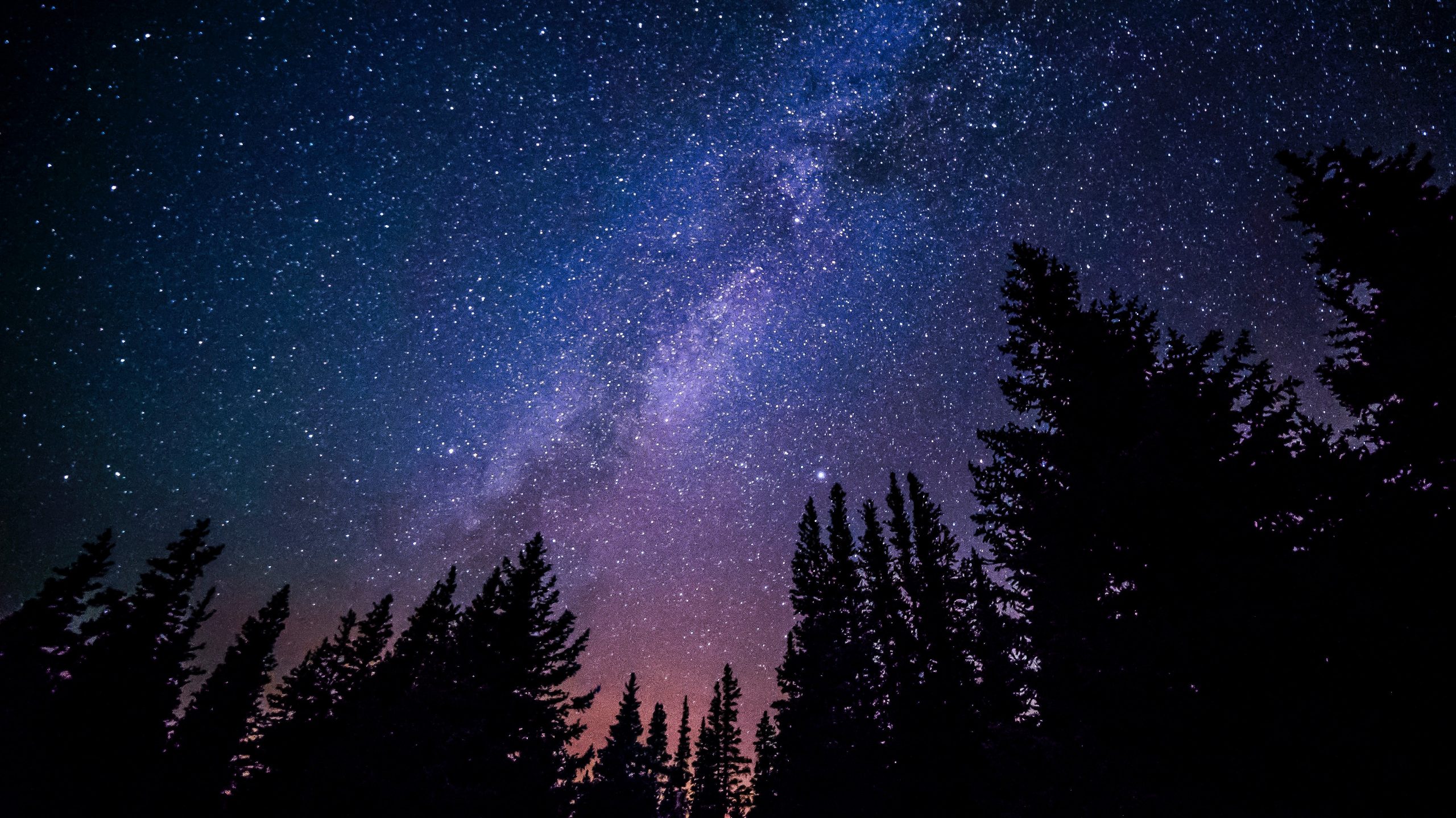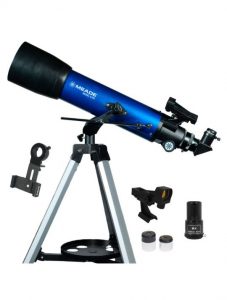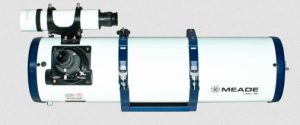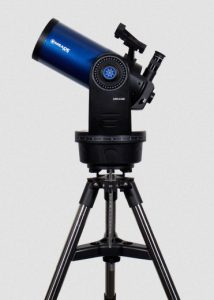Photo by Ryan Hutton on Unsplash Star Light, Star Bright… |
| One of the delights of RV camping is enjoying quiet evenings under the stars. But have you ever wondered just what you were looking at? You’ve driven for several hours and finally arrived at your chosen campsite for the night. It’s great – no phones, no emails, no distractions whatsoever. So you sit outside enjoying the evening, perhaps with a glass of wine in hand, and gaze up at the stars. Away from the glaring city lights, it’s truly remarkable just how many there are to see. One particularly bright star off to the right catches your eye. Is it the North Star? Or is it the planet Venus? Or is it a distant galaxy blowing to bits in a massive nuclear explosion?
Astronomy is one of those things that can be as simple or as complex as you care to make it. You can enjoy stargazing with just the naked eye, or dive right in and seek out specific stars and constellations with a high-powered telescope. It’s all up to you. The best way to begin exploring the solar system is with a star chart, which is available at any good telescope store. Consider it a map of the sky. Being able to look up and say, “There’s the North Star!” or “That’s Saturn!” will provide anyone with a sense of satisfaction — and a sense of your place in the cosmos — that sticks with you for life. Beginning with a star chart and your naked eye makes a lot of sense, especially if your RV has limited storage space. There’s plenty to take in, providing you know where to look. That’s where your chart comes in. The average person with average vision can clearly see a galaxy two-an-a-half million light-years away with just the naked eye. Is that cool or what? Learning the night sky with a star chart takes time, but brings hours of entertainment all on its own. Besides, those skills will pay big dividends should you become hooked on stargazing and wind up buying a serious telescope. How do you learn the night sky? Just look up and let curiosity take over. Identify things that grab your attention by comparing them against your star chart. Before long, you’ll learn some different constellations or perhaps a planet or two, and find you’re having a ball. That Long Distance Feeling Binoculars come in a range of sizes, the most common being 7×35 or 7×50. The first number refers to the magnification –7×35 binoculars magnify the image by a factor of seven. The second number – the 35 – refers to the diameter of the objective lenses, measured in millimetres. A 7×35 binocular offers the same magnification as a 7×50 model, but the 7×50 has larger lenses, so it lets in more light and is a better choice for looking at the stars. Binoculars offer a number of advantages over telescopes, particularly to RV’ers who may have to cope with tight storage issues. Apart from being less expensive to buy, binoculars show you a wider view of the sky, so it is much easier to find things when you’re first getting your feet wet. They also give you a view that’s right side up and straight in front of you, making it easy to see where you’re pointing. Binoculars are also versatile – you can use them to watch birds, wildlife or anything else, so you get much more everyday use out of them. And their performance is surprisingly respectable. Ordinary 7- to 10-power binoculars improve on the naked eye about as much as a good telescope improves on binoculars. You can use them to identify our moon’s craters, the ever-changing positions of Jupiter’s moons, and the crescent phases of Venus. They’ll reveal most of the 109 star clusters, galaxies and nebulae catalogued by 18th-century astronomer Charles Messier – the so-called M List you’ll run across in astronomy books and magazines. Moreover, the skills you’ll develop using binoculars are exactly the skills you’ll need to put a telescope to good use should you one day decide to invest in one. So when you feel the desire to get more up close and personal with our solar system, start with a good pair of binoculars. If you find you’ve been bitten hard by the astronomy bug, then you can go all out and invest in a telescope. How to Buy a Telescope Many people believe that magnification, or power, is the most important feature of a telescope. That’s a mistake. Makers of poor quality telescopes take advantage of this by claiming their telescopes provide absurdly high magnification, such as “525x” or “675x.” It sounds great, but this is a sure sign of a lousy product. Actually, the main purpose of a telescope is not to magnify, but to gather light. The more light you can gather, the more you will see. As with binoculars, the light-gathering ability of a telescope is determined by the diameter of the scope’s main lens. Once you have gathered the light, then you can adjust the magnification of a telescope by using different eyepieces, much like changing lenses on a camera. Most stargazing is done at relatively moderate magnifications of 50x to 150x. Once you go much beyond that, vibration from the slightest source will make it almost impossible to focus on anything. The best place to buy a telescope is from a store that specializes in astronomy. You’ll not only find better quality merchandise at these specialty stores, but great advice as well. Dealers are generally quite willing to explain things and recommend a scope that is right for your particular use.
Selecting a telescope is a matter of making acceptable trade-offs, based on how much you will use it, how much storage space you have available in the RV, and how much you want to spend on your new hobby. There’s no point buying a pricey, computer-controlled, behemoth scope only to find you never use it because it’s such a pain in the neck to set up. A simpler, less expensive telescope that actually gets taken out and used is a far better investment. Astronomy is a lot of fun. Because our RVs take us away from the glaring city lights, campers have the best opportunity to really enjoy this fascinating pastime. Next time you’re hanging out under the stars, gather the kids, take a look up in the sky and see what catches your eye. You may find you’ve discovered a great new hobby that brings a lifetime of pleasure. Points to Remember • Avoid cheap department store and toy store telescopes, which tend to be low in quality. • The primary purpose of a telescope is to gather light. So look for a scope that’s large enough in diameter to offer bright images, yet compact enough to fit its storage space in your RV. If the telescope is too large or too much of a pain to set up, you won’t use it, regardless of image quality. What You Can Expect to See • All of the planets except Pluto. Saturn’s rings are easy to spot, as is the planet Jupiter. Detail on Mars is a bit harder to pick out, but possible on a clear night. Venus, Mercury, Neptune and Uranus are pretty much featureless balls. • Hundreds of named craters and mountain ranges on our moon. • Sunspots and other activity on the sun, if you have a proper filter. But unless you really want to incinerate your eyeballs, do not look at the sun without proper filtration! • All 109 Messier objects, which include nebulae, open and globular clusters, and extended galaxies. Most of these will seem impossibly dim to you at first. Once you become comfortable looking at the night sky, they will seem terribly bright. • Hundreds of other various objects, from meteors to comets. For more information on telescopes, please visit https://www.meade.com/ An Astronomy Glossary Aperture Aphelion Astronomical Unit Black Hole Bolide Celestial Sphere Declination Diurnal motion Ecosphere Equator, celestial Equatorial mount Faculae Light Pollution Light Year Orbit Satellite Solar System Spectroscope Sunspots Universal Time Zenith Interested in star gazing? Read this article next…
|



















 With such amazing views outside on every clear night, it’s little wonder that many RV’ers develop an interest in astronomy. If you travel with kids in tow, it’s only a matter of time until they start asking about the stars, whether the moon really is made of cheese, or if there are little green people living on Mars. What better way to introduce children to science than by letting them explore the sky above?
With such amazing views outside on every clear night, it’s little wonder that many RV’ers develop an interest in astronomy. If you travel with kids in tow, it’s only a matter of time until they start asking about the stars, whether the moon really is made of cheese, or if there are little green people living on Mars. What better way to introduce children to science than by letting them explore the sky above?





